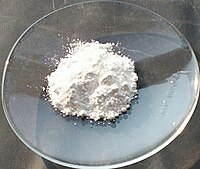
Photo from wikipedia
Aqueous supercapacitors based on neutral solutions have the advantages of high-ionic conductivity, being environmentally friendly, safe, and low cost. However, the operating potential window for most aqueous electrolytes is far… Click to show full abstract
Aqueous supercapacitors based on neutral solutions have the advantages of high-ionic conductivity, being environmentally friendly, safe, and low cost. However, the operating potential window for most aqueous electrolytes is far lower than that of organic electrolytes that are commonly used in commercial supercapacitors. In this work, we report on the fabrication of a wide potential window, high-energy aqueous asymmetric supercapacitor, without sacrificing power, by using a nanostructured LiMn2O4/reduced graphene oxide (LMO–rGO) nanocomposite. We synthesized the uniformly distributed LMO in the LMO–rGO nanocomposite using a co-precipitation route followed by a low-temperature hydrothermal treatment. In a three-electrode cell setup, the specific capacitance of the LMO–rGO nanocomposite electrode at 1 A/g (1.2 mA/cm2) is 268.75 F/g (258 mF/cm2), which shows a dramatic improvement over the sum of the specific capacitances of pristine LMO (162.5 F/g) and pure rGO (29.94 F/g) electrodes in their relative ratios, when used alone. This finding suggests a synergistic coupling of LMO and rGO in the nanocomposite. We also assembled the LMO–rGO nanocomposite, as the positive electrode, with activated carbon, as the negative electrode, into an asymmetric cell configuration. The device shows an ultra-wide potential window of 2.0 V in a neutral aqueous Li2SO4 electrolyte, with a maximum energy density of 29.6 Wh/kg (which approaches the commercial lead-acid batteries), power density of up to 7408 W/kg, and an excellent cycle life (5% loss after 6000 cycles). These findings confirm that an LMO–rGO nanocomposite is a promising material to meet the demands of real world energy storage.
Journal Title: Journal of the Iranian Chemical Society
Year Published: 2017
Link to full text (if available)
Share on Social Media: Sign Up to like & get
recommendations!